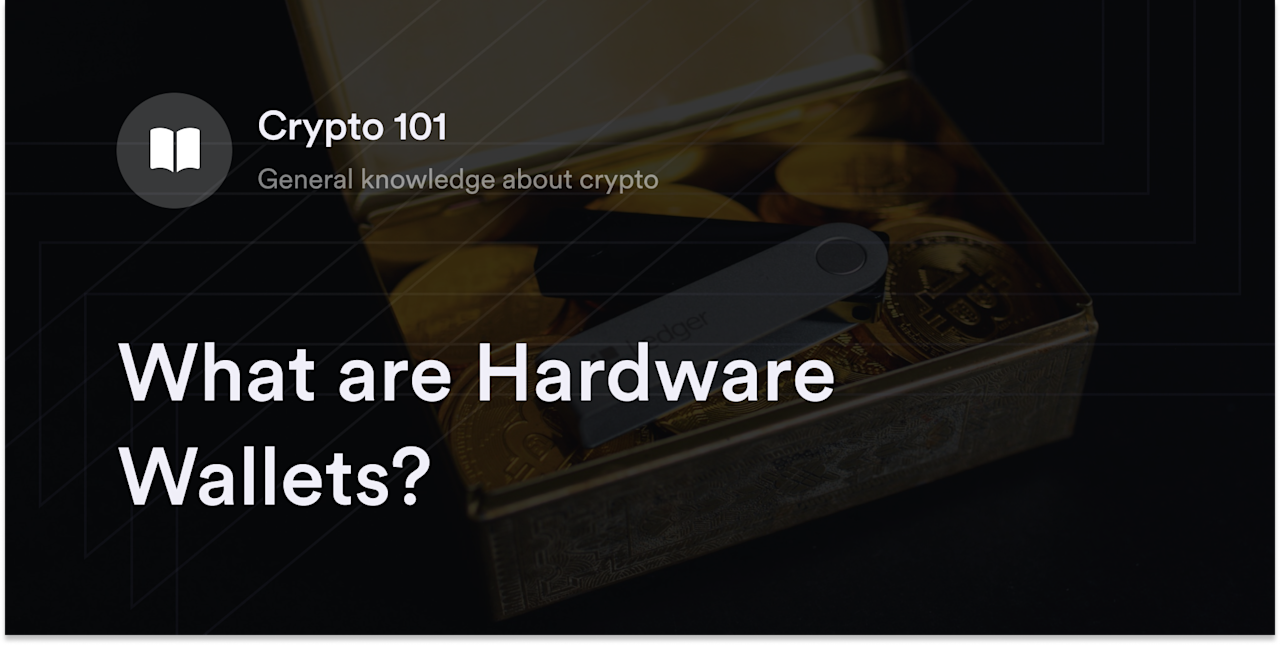


Cryptocurrency’s vast popularity (and sometimes minute loopholes in blockchain networks) has made it vulnerable to many scams. Hackers are always on the move to break into a wallet and drain all the digital assets, leaving the wallet owner with zero. Unlike precious metals or paper dollars, crypto traders can't put their digital currencies in a physical vault for safekeeping. So how do they ensure their crypto assets are safe? Enter: the power of technology.
Members of the crypto community rely on hi-tech solutions, such as hardware and software wallets, for their crypto storage needs. Although these aren't the only way to store cryptocurrencies, hardware wallets have become one of the most preferred options, especially for people who prioritize security. In fact, sales data suggests the global hardware wallet market is already worth $389.28 million, and some analysts predict it to surpass the $1 billion mark before 2030.
So exactly what is a hardware wallet, and why do so many crypto traders trust these units with their crypto assets? Below, we’ll explore the pros and cons of using hardware wallets and whether they’re the safest option for crypto storage.
What is a Hardware Wallet in Crypto?
A crypto hardware wallet is a physical device used for safeguarding digital assets; every wallet has a unique private key and a public key. While the former is a long string of letters and numbers, providing crypto traders exclusive access to virtual funds, the latter is derived from the private key and shared with other crypto traders to send and receive virtual currency.
What is a Private Key? A More In-Depth Look
Think of a crypto hardware wallet’s private key as the literal key to a property, while the public key is the home address for different crypto assets. Also, private keys are the only backup if traders break or lose a wallet and need to restore funds on a new account.
Unlike software wallets––which are web-based apps that keep the private keys on a user's desktop or mobile phone––hardware wallets are only online when a user connects the physical device to a computer or phone. Since the private keys in hardware wallets are offline when not in use, they're in a wallet category known as cold wallets. In contrast, all internet-based crypto wallets are called hot wallets because they're always online. Although many different hardware wallet types exist, most of these units resemble crypto USB sticks or have Bluetooth connectivity.
How do Hardware Wallets Work?
When traders log in to a crypto hardware wallet, they seem to store digital assets like Bitcoin (BTC) or Ethereum (ETH) in their devices. In reality, cryptocurrencies only exist on their decentralized networks (aka blockchains), and hardware wallets use crypto key storage to determine who has access to which coins and tokens.
A hardware wallet's private key and public key create a unique address on supported blockchains where traders keep their virtual currencies. Each wallet's public and private keys are interrelated, but they use advanced cryptography to make it impossible to decrypt the private key from the public key. So when people set up their hardware crypto wallets, they safely use their public key address to send cryptocurrencies like Bitcoin to their account without revealing their essential private key.
The distinctive feature of hardware wallets is they store the private keys inside the device, making it difficult even for skilled hackers to break into accounts. Additionally, traders with a hardware wallet need to link their device to a computer or phone to confirm (aka sign) every crypto transaction, adding another layer of security.
Hardware wallet users usually see their private key as a 12–24-word seed phrase during setup. For context, the seed phrase corresponds with a wallet's private key. But instead of random alphanumeric strings, this seed phrase has easy-to-read words like "dizzy" and "school." Developers often use seed phrases because they're easier to remember than the literal private keys, and users are less prone to make mistakes when copying them down for safekeeping.
Pros and Cons of Using Hardware Wallets
Hardware wallets are known for their safety features, but there are some disadvantages associated with these devices. Novice crypto traders should weigh the benefits and drawbacks of using hardware wallets to figure out whether it's right for their strategy.
Hardware Wallet Pros
Superior safety: Since the private key on a hardware wallet is online, hackers can't break into these accounts. The extra degree of separation hardware wallets provide makes them less vulnerable to cybercriminals than software wallets.
Transaction confirmation: Another way hardware wallets protect users' funds is by asking for confirmations before every crypto transfer. Traders often need to input their PIN or a password before sending cryptocurrencies, reducing the chances of cyber-theft.
Durability: Hardware wallets are typically made with durable materials like steel or reinforced plastic to withstand accidental bumps and aging. With proper care, high-quality hardware wallets last a lifetime.
Hardware Wallet Cons
Varied cost: There are multiple hardware wallet models and brands at different prices, but none are free. Unlike software wallets, there's always an upfront investment for a hardware wallet.
Higher learning curve: Hardware wallets are deliberately "clunky" compared to most software wallets. While the cumbersome nature of hardware wallets adds to their security, it takes more time to figure out how to properly link it to a computer and sign crypto transfers.
Less convenient in Web3: Decentralized applications (dApps) typically have seamless integrations with software wallets like MetaMask rather than hardware devices. Therefore, people interested in exploring Web3 fields like decentralized finance (DeFi) or non-fungible token (NFT) trading typically prefer internet-based wallets over fumbling with a hardware device.
How to Set up a Hardware Crypto Wallet
Each hardware crypto wallet has a distinct setup process, but most follow a similar method:
Open the hardware wallet's official software interface on the company's website (e.g., Trezor hardware wallets use the Trezor Suite app, while Ledger crypto wallets use Ledger Live).
Plug the hardware device into a PC with a USB cable or link with Bluetooth.
Select "Create a New Wallet."
Create a password or PIN for the wallet account.
Reveal the seed phrase, and write it on paper.
Double-check that the seed phrase is correct with a brief quiz.
Ensure the wallet's app has the latest firmware updates.
When setting up a hardware crypto wallet, take extra time to confirm every word in the seed phrase is spelled correctly and in the proper order on a backup sheet. Some crypto traders store their seed phrase in an encrypted file or take a photo and store it in a cloud server, but the only hack-proof way to record this info is with a pen and paper or on specialized seed recovery sheets made with a durable material like steel.
As a safety precaution, it's best practice to buy hardware wallets directly from the manufacturer rather than on third-party sites like eBay. There aren't as many quality controls in the hardware wallet resale market, and bad actors sometimes download malware into hardware wallets or pre-program a seed phrase to steal crypto from innocent victims.
Examples of Hardware Crypto Wallets
Competition in the hardware crypto wallet market is fierce, which means customers have dozens of options to consider before committing. However, a few hardware wallet manufacturers have a long reputation in the crypto industry for their best-selling products:
Trezor: In 2013, two Czech crypto enthusiasts made history when they launched the first hardware Bitcoin wallet: the Trezor Model 1. Now a part of SatoshiLabs Group, Trezor is the oldest and one of the most influential hardware wallet manufacturers.
KeepKey: Created by computer programmer Darin Stanchfield, KeepKey is an American hardware wallet manufacturer that opened in 2014. In 2017, crypto exchange ShapeShift acquired KeepKey but later spun it off as an independent venture. Although ShapeShift isn't as involved with KeepKey, the two companies still have close ties and integrations.
Ledger: Ledger is a Paris-based hardware wallet manufacturer founded in 2014. Since its launch, Ledger has sold approximately 6 million units worldwide. Among its signature hardware wallets are the Ledger Nano S and the Ledger Nano X.
Are Hardware Wallets the Way to Store Crypto for You?
Because hardware wallets store private keys offline, they are a popular option from a security standpoint. Even the most sophisticated hot wallets have a higher risk of hacks because they're always plugged into the internet. For this reason, crypto traders most concerned about preventing cyberattacks typically gravitate toward high-quality hardware units.
However, hardware wallets aren't necessarily the right option for every trader. Choosing the right crypto storage strategy generally depends on a trader's preferences and risk tolerance. For example, some crypto traders like to store most of their crypto assets on software applications for greater convenience in DeFi applications. Also, not all hardware wallets are created equal, and some low-quality devices may have worse security standards than a well-reviewed hot wallet. Traders need to take plenty of time researching different hardware wallet brands and products before deciding which is the right one for their risk tolerance and financial goals.
Learn More Tips on Crypto Security on dYdX Academy
dYdX is on a mission to educate everyone on the basics of trading, storing, and sending cryptocurrencies. With the dozens of guides on dYdX Academy, traders can learn the ins and outs of essential crypto topics, including proper wallet installation, private keys, and avoiding common scams like pump and dump schemes.
We also offer eligible traders a secure decentralized trading platform for traders interested in perpetual swaps. Find out more about dYdX's latest features and updates on our official blog, and eligible traders can start trading on dYdX today.
Disclaimer
The content of this article (the “Article”) is provided for general informational purposes only. Reference to any specific strategy, technique, product, service, or entity does not constitute an endorsement or recommendation by dYdX Trading Inc., or any affiliate, agent, or representative thereof (“dYdX”). Use of strategies, techniques, products or services referenced in this Article may involve material risks, including the risk of financial losses arising from the volatility, operational loss, or nonconsensual liquidation of digital assets. The content of this Article does not constitute, and should not be considered, construed, or relied upon as, financial advice, legal advice, tax advice, investment advice, or advice of any other nature; and the content of this Article is not an offer, solicitation or call to action to make any investment, or purchase any crypto asset, of any kind. dYdX makes no representation, assurance or guarantee as to the accuracy, completeness, timeliness, suitability, or validity of any information in this Article or any third-party website that may be linked to it. You are solely responsible for conducting independent research, performing due diligence, and/or seeking advice from a professional advisor prior to taking any financial, tax, legal, or investment action.
You may only use the dYdX Services in compliance with the dYdX Terms of Use available here, including the geographic restrictions therein.
Any applicable sponsorship in connection with this Article will be disclosed, and any reference to a sponsor in this Article is for disclosure purposes, or informational in nature, and in any event is not a call to action to make an investment, acquire a service or product, or purchase crypto assets. This Article does not offer the purchase or sale of any financial instruments or related services.
By accessing this Article and taking any action in connection with the information contained in this Article, you agree that dYdX is not responsible, directly or indirectly, for any errors, omissions, or delays related to this Article, or any damage, injury, or loss incurred in connection with use of or reliance on the content of this Article, including any specific strategy, technique, product, service, or entity that may be referenced in the Article.







